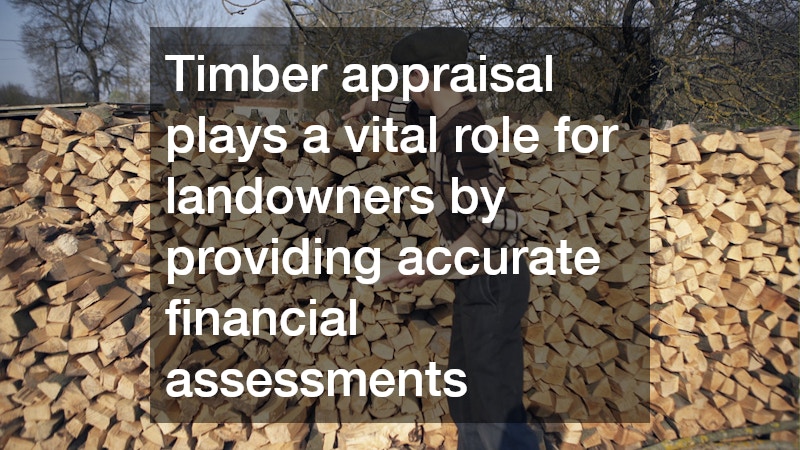The Importance of Professional Timber Appraisal
Understanding the significance of professional timber appraisal is crucial for landowners, investors, and forestry professionals. Explore various aspects of timber appraisal, including insights into its benefits, methodologies, and relevance in today’s market.
What Is Professional Timber Appraisal?
A professional timber appraisal is a systematic evaluation of the economic value of timber resources on a given parcel of land. It involves assessing the quantity, quality, and market value of trees, providing an essential service for stakeholders in the forestry sector.
The appraisal process ensures that landowners have a precise understanding of the worth of their standing timber, enabling informed decision-making.
The importance of timber appraisal cannot be overstated, especially given the increasing demand for transparency and accountability in the forestry industry. Accurate appraisals benefit not only landowners but also investors interested in purchasing timberland or engaging in sustainable forestry practices. With accurate valuation, stakeholders can navigate complex timber markets confidently, ultimately contributing to better resource management.
Moreover, professional timber appraisal is essential for compliance with regulations and financial standards. Whether for tax assessments or legal disputes, having a certified appraisal helps safeguard the interests of landowners and forestry professionals alike. This process serves as a foundation for fair negotiations and transactions involving timber assets, reinforcing the credibility of the forestry sector.
Why Is Timber Appraisal Necessary For Landowners?
Timber appraisal plays a vital role for landowners by providing accurate financial assessments of their timber resources. Understanding the value of timber can significantly impact decisions related to harvest timing, sale negotiations, and reforestation strategies. For landowners looking to optimize their profits, knowing the appraised value of their resources can make a substantial difference.
Additionally, professional timber appraisal aids in legal contexts, where landownership disputes or inheritance issues may arise. Having a documented appraisal ensures that landowners can defend the value of their assets in legal proceedings or Estate planning. This legal clarity is especially important as it pertains to ensuring fair distribution amongst heirs or in cases of property tax assessments.
Ecologically, timber appraisal assists in guiding sustainable practices. By understanding the overall health and value of a forest stand, landowners can make decisions that not only enhance their economic return but also promote biodiversity and rehabilitation. Effective management strategies, informed by professional timber appraisals, can lead to improved forest ecosystems, benefiting both the environment and landowners in the long run.
How Is Timber Valued During An Appraisal?
The valuation of timber during an appraisal involves several methodologies and techniques that reflect the unique characteristics of the timber resource. Common approaches include the comparative sales method, which evaluates the value of timber based on recent sales of similar properties. Additionally, cost approach and income yield methods are employed to provide a comprehensive understanding of timber worth.
Key factors influencing timber value include species, quality, age, and market demand. Each of these elements contributes to the potential revenue that can be generated from timber harvesting. Appraisers must assess stand density, growth rates, and site conditions to arrive at an accurate valuation, ensuring that all relevant aspects are considered.
Furthermore, appraisers often utilize technology such as GIS (Geographical Information Systems) and remote sensing software to enhance the accuracy of their evaluations. These technological advances provide valuable data on forest composition and growth patterns, ultimately enabling more precise appraisals. In a market where understanding timber value is pivotal, utilizing sophisticated methods elevates the appraisal process, ensuring all factors are adequately represented.
What Are The Common Mistakes To Avoid In Timber Appraisals?
Common mistakes in timber appraisals often stem from a lack of comprehensive understanding of key metrics and variables affecting timber value. One frequent oversight is failing to consider the differences between standing timber values and stumpage values, which can lead to significant discrepancies in appraisals. It is essential for appraisers to clearly differentiate these in reports and analyses to provide accurate valuations.
Another mistake is neglecting to update appraisals based on changing market conditions and timber growth rates. Timetable factors such as timber quality and age may evolve, but without regular assessment, the initial valuation can become obsolete. Consequently, appraisers should ensure that they are employing current data and methodologies to maintain relevant and accurate valuations.
Lastly, underestimating the ecological factors affecting timber value is a common pitfall. Appraisals should not solely focus on financial estimations; they must also take into account the health of the forest ecosystem. Failing to evaluate the ecological context can misrepresent the true value of timberland and adversely affect sustainable management practices.
How Can Professional Timber Appraisal Impact Forest Management?
Professional timber appraisal significantly influences effective forest management strategies and policies. Establishing a solid financial baseline assists forest managers in aligning their practices with both economic objectives and ecological sustainability. Accurate appraisals equip managers with essential insights into resource allocation and management priorities.
This process also enhances conservation efforts by helping land managers recognize the biodiversity value of forests beyond mere timber production. Timely and professional appraisals can guide decisions that focus on preserving unique ecological features, ensuring the longevity of forest ecosystems. Understanding the multifaceted value of timberland promotes an integrated approach to forest stewardship.
Lastly, professional timber appraisals bridge the gap between market demands and sustainable practices. By providing clarity on timber market values, appraisers can aid forest managers in making decisions that promote sustainable timber harvesting while also maximizing economic returns. The intersection of valuation and sustainable forest management ultimately supports healthy, productive forests that serve both ecological and economic purposes.
Professional timber appraisal plays a vital role in the forestry industry, assisting stakeholders in making informed decisions. Whether for investment, sale, or conservation, understanding timber appraisal is essential for maintaining the value and sustainability of forest resources.




